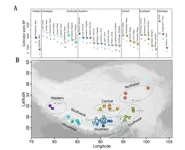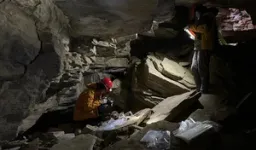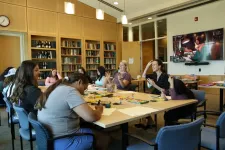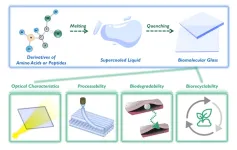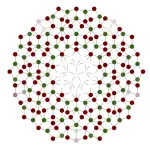(Press-News.org) In space travel, custom parts for vehicles such as rockets and satellites are often needed quickly to accommodate changes in design, as well as for repair and functionality purposes. Additive manufacturing is an ideal technology to meet these needs, as components can be made through a relatively short cycle of design, build, and test. However, this cycle must be continually refined in order to ensure the quality and reliability of the 3D printed parts.
A new NASA Space Technology Research Institute (STRI) led by Carnegie Mellon University seeks to shorten the cycle required to design, manufacture, and test parts that can withstand the conditions of space travel through the development of models for qualification and certification (Q&C).
First set up in 2016, the overall STRI program aims to strengthen NASA’s ties to the academic community through long-term, sustained investment in research and technology development, while also fostering talent among highly-skilled engineers, scientists, and technologists.
The $15 million project, Institute for Model-based Qualification & Certification of Additive Manufacturing (IMQCAM), will be co-directed by Tony Rollett, a professor of materials science and engineering at Carnegie Mellon University, and Somnath Ghosh, a professor of civil and systems engineering at Johns Hopkins University.
“In order to make a printed product have predictable properties, we need to understand more about what its internal structure is, how it depends on the printing process, and what properties it has,” said Rollett. “The STRI affords us an opportunity for a major collaboration through which we can construct the models that our partners at NASA very much need in order to do their work.”
Over the course of five years, the institute will develop detailed computer models, or digital twins, for additively manufactured parts that have been validated against experimental data, verified against physical mechanisms, and subjected to rigorous uncertainty quantification protocols. The models will evaluate response to fatigue in spaceflight materials that are currently used for 3D printing, as well as introducing and qualifying new materials.
The project outcomes will serve as a vital resource for partners at NASA, as the models will enable them to better predict the parts’ performance abilities.
The Institute will also serve as a catalyst for recruiting and training students and post-docs to have a comprehensive understanding of the additive manufacturing Q&C process and be the future leaders in the field. Students from across institutional partners will be mentored by both STRI team members and NASA researchers throughout the project.
Carnegie Mellon faculty members Sneha Prabha Narra, Mohadeseh Taheri-Mousavi, and Bryan Webler will also contribute their expertise to the institute.
Additional institutional partners on the project include Vanderbilt University, University of Texas at San Antonio, University of Virginia, Case Western Reserve University, Johns Hopkins University Applied Physics Laboratory, Southwest Research Institute, and Pratt & Whitney.
END
Carnegie Mellon to lead NASA Space Technology Research Institute
The new NASA Space Technology Research Institute (STRI) seeks to shorten the cycle required to design, manufacture, and test parts that can withstand the conditions of space travel through constructing models for qualification and certification.
2023-03-17
ELSE PRESS RELEASES FROM THIS DATE:
DOE announces $590 million to increase bioenergy research
2023-03-17
WASHINGTON, D.C. — The U.S. Department of Energy (DOE) today announced $590 million to renew its four existing Bioenergy Research Centers (BRCs). This funding will help support the Department’s research into the next generation of sustainable, cost-effective bioproducts and bioenergy from domestic biomass resources, which is critical to reducing harmful greenhouse gas emissions, ensuring future energy security, and creating new economic opportunities in rural areas. Since their inception, the BRCs have made groundbreaking scientific contributions to and advancements ...
The University of Queensland-Ochsner Health Medical Program celebrates high residency match; see Ochsner’s full Match Day results for 2023
2023-03-17
NEW ORLEANS, La. – The University of Queensland-Ochsner Health (UQ-Ochsner) Doctor of Medicine (MD) program and Ochsner Graduate Medical Education on March 17 celebrated Match Day 2023 – a rite of passage in which applicants from around the globe learn who has been selected for which U.S. residency program to start the next chapter of medical training.
This year, 78 medical graduates from UQ-Ochsner’s Class of 2022 entered the match and received a 96% match rate through the National Residency Match Program (NRMP) – one that exceeded the national match rate for U.S. medical schools.
Leonardo ...
On World Sleep Day, new research reveals the socioeconomic impact of insomnia on global populations
2023-03-17
Insomnia is the most common sleep disorder and exacts a significant toll on an individual’s mental and physical health, quality of life and productivity. But the consequences of insomnia go well beyond the individual, with cascading effects on families, employers and global economies.
Amid growing evidence that the condition is increasing globally, new research from RAND Europe, funded by Idorsia Pharmaceuticals Ltd, Switzerland and published on World Sleep Day 2023, reveals the societal ...
Researcher-community partnership uses collaborative process to yield novel insights
2023-03-17
RIVERSIDE, Calif. -- Until recently, psychologist Kalina Michalska had never used community-based participatory research, or CBPR, in her work, but now she can’t imagine not using it.
CBPR, which dates to the early 1930s, is an intensive research approach that involves partnerships between researchers and community members throughout the research process, giving communities a voice in how the research proceeds and allowing them to make use of the findings more effectually.
The study led by Michalska, an ...
Boosting survival of a beneficial bacterium in the human gut
2023-03-17
New Haven, Conn. — The microbes that inhabit the gut are critical for human health, and understanding the factors that encourage the growth of beneficial bacterial species — known as “good” bacteria — in the gut may enable medical interventions that promote gut and overall human health. In a new study, Yale researchers have uncovered a novel mechanism by which these bacteria colonize the gut.
Specifically, the Yale team discovered that one of the most abundant beneficial species found in the human gut showed an increase in colonization potential when experiencing carbon limitation — a finding that could yield novel clinical ...
International Society for Autism Research (INSAR) 22nd Annual Meeting to be held in Stockholm, Sweden May 3- 6, 2023
2023-03-17
The International Society for Autism Research (INSAR) will hold its 2023 Annual Meeting – the organization’s 22nd – from Wednesday, May 3 through Saturday, May 6, 2023, bringing together a global, multidisciplinary group of hundreds of autism researchers, clinicians, advocates, self-advocates, and students to exchange the latest scientific learnings and discoveries that are advancing the expanding understanding of autism and its complexities. This year’s meeting will be held in-person in Stockholm, Sweden at Stockholmsmässan, the largest exhibition facility in the Nordic region.
The INSAR ...
Genomic study of ancient humans sheds light on human evolution on the Tibetan Plateau
2023-03-17
The Tibetan Plateau, the highest and largest plateau above sea level, is one of the harshest environments settled by humans. It has a cold and arid environment and its elevation often surpasses 4000 meters above sea level (masl). The plateau covers a wide expanse of Asia—approximately 2.5 million square kilometers—and is home to over 7 million people, primarily belonging to the Tibetan and Sherpa ethnic groups.
However, our understanding of their origins and history on the plateau is patchy. Despite a rich archaeological context spanning the plateau, ...
Key role identified for nervous system in severe allergic shock
2023-03-17
DURHAM, N.C. – A key feature of the severe allergic reaction known as anaphylaxis is an abrupt drop in blood pressure and body temperature, causing people to faint and, if untreated, potentially die.
That response has long been attributed to a sudden dilation and leakage of blood vessels. But in a study using mice, Duke Health researchers have found that this response, especially body temperature drop, requires an additional mechanism – the nervous system.
Appearing online March 17 in the journal Science Immunology, the study could ...
Researchers develop biodegradable, biorecyclable glass
2023-03-17
Everyone is familiar with glass—from putting on eyeglasses, pushing open the window, standing in front of a mirror, to holding a water glass. Glass is ubiquitous in nature and essential to human life.
But the widespread use of persistent, non-biodegradable glass that cannot be naturally eliminated causes long-term environmental hazards and social burdens.
To solve this problem, a research group led by Prof. YAN Xuehai from the Institute of Process Engineering (IPE) of the Chinese Academy of Sciences has developed a family of eco-friendly glass of biological origin fabricated from biologically derived amino acids or peptides. The ...
Qubits put new spin on magnetism: Boosting applications of quantum computers
2023-03-17
LOS ALAMOS, N.M., March 17, 2023 — Research using a quantum computer as the physical platform for quantum experiments has found a way to design and characterize tailor-made magnetic objects using quantum bits, or qubits. That opens up a new approach to develop new materials and robust quantum computing.
“With the help of a quantum annealer, we demonstrated a new way to pattern magnetic states,” said Alejandro Lopez-Bezanilla, a virtual experimentalist in the Theoretical Division at Los Alamos National Laboratory. ...
LAST 30 PRESS RELEASES:
SIMJ announces global collaborative book project in commemoration of its 75th anniversary
Air pollution exposure and birth weight
Obstructive sleep apnea risk and mental health conditions among older adults
How talking slows eye movements behind the wheel
The Ceramic Society of Japan’s Oxoate Ceramics Research Association launches new international book project
Heart-brain connection: international study reveals the role of the vagus nerve in keeping the heart young
Researchers identify Rb1 as a predictive biomarker for a new therapeutic strategy in some breast cancers
Survey reveals ethical gaps slowing AI adoption in pediatric surgery
Stimulant ADHD medications work differently than thought
AI overestimates how smart people are, according to HSE economists
HSE researchers create genome-wide map of quadruplexes
Scientists boost cell "powerhouses" to burn more calories
Automatic label checking: The missing step in making reliable medical AI
Low daily alcohol intake linked to 50% heightened mouth cancer risk in India
American Meteorological Society announces Rick Spinrad as 2026 President-Elect
Biomass-based carbon capture spotlighted in newly released global climate webinar recording
Illuminating invisible nano pollutants: advanced bioimaging tracks the full journey of emerging nanoscale contaminants in living systems
How does age affect recovery from spinal cord injury?
Novel AI tool offers prognosis for patients with head and neck cancer
Fathers’ microplastic exposure tied to their children’s metabolic problems
Research validates laboratory model for studying high-grade serous ovarian cancer
SIR 2026 delivers transformative breakthroughs in minimally invasive medicine to improve patient care
Stem Cell Reports most downloaded papers of 2025 highlight the breadth and impact of stem cell research
Oxford-led study estimates NHS spends around 3% of its primary and secondary care budget on the health impacts of heat and cold in England
A researcher’s long quest leads to a smart composite breakthrough
Urban wild bees act as “microbial sensors” of city health.
New study finds where you live affects recovery after a hip fracture
Forecasting the impact of fully automated vehicle adoption on US road traffic injuries
Alcohol-related hospitalizations from 2016 to 2022
Semaglutide and hospitalizations in patients with obesity and established cardiovascular disease
[Press-News.org] Carnegie Mellon to lead NASA Space Technology Research InstituteThe new NASA Space Technology Research Institute (STRI) seeks to shorten the cycle required to design, manufacture, and test parts that can withstand the conditions of space travel through constructing models for qualification and certification.

